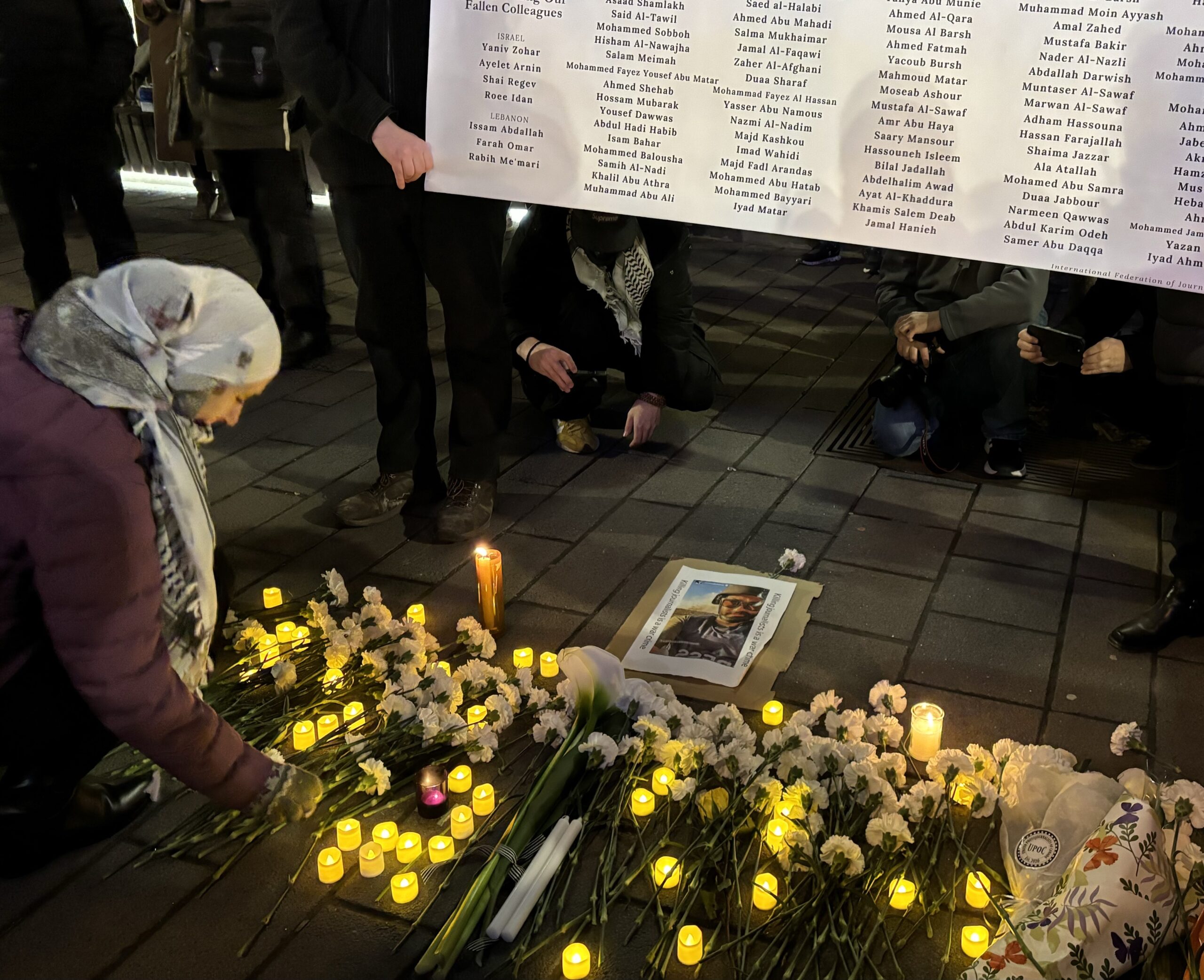Over 100 Canadian journalists gathered Thursday evening in solidarity with the dozens of journalists who have been killed since October 7. The vigil, co-organized by Canadian journalists Ginella Massa, Fatima Syed, Inori Roy, and Pacinthe Mattar to highlight the unprecedented targeting of journalists in the last four months, was held outside Toronto Metropolitan University’s Creative School on February 1.
According to the Committee to Protect Journalists (CPJ), 85 journalists have been killed since October 7: 78 in Gaza, three in Lebanon, and four in Israel. However, according to the Palestinian Journalists Syndicate and the International Federation of Journalists, the death toll is upward of 92 in Gaza.
In her opening remarks, Massa addressed the elephant in the room: the golden rule that journalists shouldn’t rally or protest. “We’re here to reaffirm our commitment to press freedom because journalism should not be a crime anywhere,” she said. Those in attendance nodded in agreement as she went on to say that journalists prioritize their own stories, but this evening, at the vigil, we were here to remember the human stories: friends, family, and colleagues. “They’ve embodied the heavy meaning of the word ‘press.’”
Mattar, expressing her gratitude for the sizable turnout of her fellow journalists, said she had no idea if 15 or 150 people would come to the vigil. “We knew it was important for us as Canadian journalists to take a stand to say something in this moment that is unprecedented in our lifetimes.”
Mattar referenced the UN Office of the High Commissioner for Human Rights press release published the morning of the vigil, in which UN experts stated, “We have received disturbing reports that, despite being clearly identifiable in jackets and helmets marked PRESS or travelling in well-marked press vehicles, journalists have come under attack, which would seem to indicate that the killings, injury, and detention are a deliberate strategy by Israeli forces to obstruct the media and silence critical reporting.”
Mattar criticized the silence of the wider journalistic community despite the fact that this has been one of the most dangerous times for journalists. Before October 7, there were approximately 1,000 journalists in Gaza. Now, with at least 100 killed, their press corps has been decimated by Israel’s military campaign. “I’d ask you to imagine, as you look around here today at your peers and colleagues, what it would look like if 10 percent of Toronto’s media were wiped out in a matter of four months,” said Mattar.
Many journalists have been put at risk of being smeared as “Hamas collaborators,” said Mattar, and that it was both heartening and rare to see that claim rejected by The New York Times and the AFP, which stood by their colleagues killed in the war. “It should not be controversial or cost us our jobs or livelihoods to say we deserve the right to do our lifelong work of documenting, telling stories, and communicating to the world without fear of death,” said Mattar.
Mattar brought attention to the fearless journalists who have been working tirelessly to document what is happening in Gaza. Lama Jamous, nine-year-old girl from Gaza, is documenting the displacement on her social media. She is currently at the Rafah border trying to evacuate with her family. “No child anywhere,” she said, ”should be tasked with reporting on a war.”
Mattar also brought attention to Mansour Shouman, a Palestinian-Canadian citizen journalist feared to have been detained by the Israeli Defence Force (On Tuesday February 6, Shouman confirmed via. Instagram LIVEthat he is alive, and had been running for cover in Gaza for two weeks without any electronic devices, due to being targeted by the IDF); Motaz Azaiza, a Palestinian photojournalist who captured what was happening in Gaza on his camera, barely escaped death, and evacuated Gaza; and Wael al-Dahdouh, who lost five of his family members in an Israeli air strike, then later his wife, daughter, and his son Hamza—a fellow journalist who was buried earlier this year. Mattar continued to list those who have lost everything to bring coverage of Gaza to the outside world. “It’s largely Palestinian journalists who have paid a cost no journalist should have to by covering this war.”
Mississauga-based journalist Fatima Syed then read an excerpt from Aaron Heller’s Associated Press obituary for Yaniv Sofer, his colleague of 15 years. Sofer, an Israeli photographer, was killed along with his wife and daughters on October 7. “He was a wonderful friend, a devoted father, a man with heart and generosity,” read Syed.
Palestinian-Canadian advocate Shireen Salti delivered a message on behalf of Anton Abu Akleh, the brother of Palestinian journalist Shireen Abu Akleh, who was killed by an Israeli sniper in 2022 while reporting on Israel’s military incursion into the Jenin camp for refugees in the occupied West Bank territories. Salti said, “Shireen was the eyes and the ears of the Palestinian people spreading the message of their daily struggles under occupation.”
Salti described how events like the vigil to honour Shireen’s legacy are important because it shows her impact. Additionally, Salti said, as we bear witness to the genocide being committed in Gaza, current Palestinian journalists have been “fearlessly documenting the horrors being committed and giving voice to the Palestinians being dehumanized by Western media.”
Following Salti’s speech, the event recognized a number of poets and writers who have also been targeted and killed. Josh Bloch, an audio producer, read aloud poet Nour al-Din Hajjaj’s last message to the free world before he was killed by Israel.
My name is Nour al-Din Hajjaj, I am a Palestinian writer, I am twenty-seven years old and I have many dreams.
I am not a number and I do not consent to my death being passing news. Say, too, that I love life, happiness, freedom, children’s laughter, the sea, coffee, writing, Fairouz, everything that is joyful—though these things will all disappear in the space of a moment.
One of my dreams is for my books and my writings to travel the world, for my pen to have wings so that no unstamped passport or visa rejection can hold it back.
Another dream of mine is to have a small family, to have a little son who looks like me and to tell him a bedtime story as I rock him in my arms.
“Of course,” said Massa, “we know that Nour did not make it to see those dreams realized, but we hope that in death, we can make Nour’s dreams come true, that his writings do travel the world.”
“We are going to say their names now,” said Massa. Emotions stirred as each name was called out. Attendees approached the banner to pay their respects, and lay down some flowers, candles, and signage. The vigil came to an end with a moment of silence, one second for each journalist killed.
This vigil was a reminder, as stated by Salti, that “Shireen wasn’t the first journalist nor the last. Israel’s assassination of Shireen falls into a long-standing and well-documented pattern of targeting and inciting against Palestinian journalists—and all journalists, for that matter.”
The event ended with refreshments and an opportunity for attendees to connect with one another during what has been a difficult, dark time for journalists across the country.
Massa, Mattar, Roy, and Syed organized Journalists for Journalists in partnership with the Toronto Metropolitan University’s School of Journalism, the Inspirit Foundation, Amnesty International, the Canada Press Freedom Project, Stitched! Lab, and J-Source.
This article was first published in the Review of Journalism on Feb. 3, 2024.
Prarthana is a second-year Master of Journalism student at TMU. She’s an assistant reporter at the Investigative Journalism Bureau and a producer for Beyond the U podcast series at Toronto Met Radio. She additionally has work published in Maclean’s, Broadview, and other publications. She is passionate about sharing socio-political stories about displaced and vulnerable communities on a global scale.
Saman is a Toronto-based journalist, research assistant at TMU's School of Journalism, with a background in communications.



